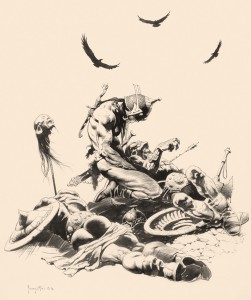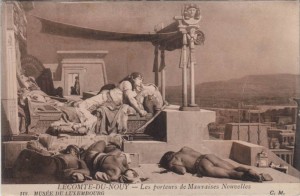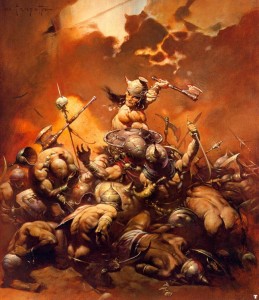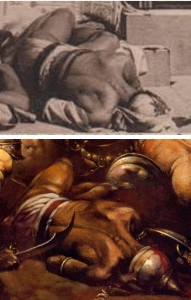Doc Dave Winiewicz is auctioning off his famous Frazetta collection. Here’s his blog. Please note that you can download a high quality 200+ page PDF of the catalog from the auction house, so click that link. You won’t see some of that stuff elsewhere. (Well, I say it’s great. So make fun of me if you like.) Looking through, I noticed something rather odd.
The fallen figure in the lower left of Frazetta’s Kubla Khan portfolio cover (catalogue, p. 51) is copied/adapted from Jean-Jules-Antoine Lecomte du Nouÿ‘s “Les porteurs de mauvaises nouvelles” (1872).
Now I know what you’re thinking. How the hell did you notice that, Holbo? Also, why are you sure Frazetta copied that figure? It’s not an exact swipe, and it’s not such a distinctive pose. The answers to your questions are: because I like dinosaurs. And: I’m pretty sure.
A couple year ago James “Dinotopia” Gurney posted on his blog that Frazetta had clearly copied a different fallen figure from “Les porteurs” into a different picture, his cover for Conan The Destroyer. (Gurney credits Craig Elliott with noticing first.)
Here is Gurney’s comparison shot:
The Destroyer was painted in 1971. The Kubla Khan stuff was done in 1975-7. Doc Dave has a post containing roughs for the KK picture. One of them contains a twisted figure, looking a bit like the one that ended up in The Destroyer.
Anyway, the fact that Frazetta clearly knew and copied the one figure suggests the strong resemblance of the other is no coincidence.
This issue gets Frazettaheads all upset. Frazetta, a swiper! There’s the galleon that got passed down, Pyle to Wyeth to Frazetta. But I call that an homage. But the “Porteurs” case is odd. Two figures from the same minor work of French Orientalist Academicism into two different Frazettas? I would not have guessed such a thing could be.
I was teaching science fiction this semester and I talked – briefly! only briefly! – about how there is a connection between pulpy/golden age fantasy/science fiction artistic sensibilities and “l’art pompier”. (That’s French for “Men Wearing A Military Helmet And Nothing Else In Western Art History”.)
A good book on the subject is James Harding, Artistes Pompiers: French Academic Art in the 19th Century. He makes some points about internal dynamics of academic styles that were non-obvious to me. Why Orientalism? Because imperialism. But there’s more. Academic art was confronted by a dilemma: Realism! We can’t ignore it, but we can’t bear to paint contemporary scenes, because that would be sordid or merely fashionable.
For the traditional academic artist, steeped in classical myth and history, with an extensive knowledge of the Bible and a detailed acquaintance with the glorious episodes from the history of France, the advent of Realism presented problems which could be resolved in a number of different ways. Fortunately for them, almost at the moment when nineteenth century artists were faced with the greatest pressure to accept and assimilate the concept of Realism or contemporaneity the French discovered the East. The Orientalists found a world uncontaminated by Social Realism in its more unacceptable forms. Here there was scenery untouched by urban development, costume unaffected by changing fashions and a way of life, hallowed by tradition, dating back almost to the beginning of the history of the modern world. Delacroix indicated the solution to the problem of integrating the classical tradition with the demands of Realism when he wrote from his journey to the East to say that he had found ancient Romans in the streets of Algiers. An artist like Gérôme who was, throughout his life, bitterly opposed to the decline of the academic tradition – reserving his most stinging criticism for the despised Impressionists – found that the combination of Neo-Classical history painting and Orientalism, interspersed with a few excursions into the seventeenth century and the Napoleonic era, provided enough subject matter for his painting. To Gérôme Realism was simply a matter of historical and architectural research.
Another interesting feature of art pompier is the degree to which it was, not just academic, but state-sponsored – official. Gustave Courbet gave that as his reason for refusing election to the Academy. (Not just that he’d been kicked around for decades, so screw you!) But that’s another story.
Another interesting catalog, if you ever happen to lay hands on it, is Art Pompier: Anti-Impressionism, 19th Century French Salon Painting. It goes with an exhibition from 1974. The accompanying text is … peculiar at points. All this academic stuff died so completely – it was junk! – then recovered only starting in the 70’s. (I tried to explain this to the older daughter a few years ago: how and why people thought Picasso’s “Nude On A Beach” was genius, but Bouguereau was crap. She didn’t get it. It’s genuinely hard to explain.) Anyway, I am bemused that, while “Art Pompier” was opening in the Emily Lowe Gallery in New York, in 1974, Frank Frazetta was off in Pennsylvania, borrowing for the second time from a Jean-Jules-Antoine Lecomte du Nouÿ he maybe got from Roy Krenkel at some point.
I love Frazetta. I couldn’t unwire those early Conan connections if I tried, and I don’t try. I also think he was a tremendous talent – a genius, I guess. It sounds a bit silly to praise his design sense rather than simply observing, more obviously, that he liked boobs and butts, among other things. (The text for the auction catalog reminds me, at points, of R. Crumb’s text for “Art and Beauty”. Google it.) But it’s still true that Frazetta had wonderful design sense. He’s as influential as Jack Kirby, not just for the often silly things he drew, but for the wonderful fresh shapes of those silly things. (No, I’m not just using ‘fresh shapes’ as euphemisms! If you don’t even like Jack Kirby, I’m at a loss. I don’t know what to say to you.)
It’s fun to read the parallel discussion in Harding, at a loss to decide whether 19th century Salon-goers thought that naming a canvas ‘Venus’ somehow transmuted it into not boobs and butt. “It is now difficult to gauge the extent to which the nineteenth century public was fooled by its own ingenuousness.” Even Baudelaire gets a bit silly on the subject.
If it is well-drawn there is pleasure to be gained in its very structure which has nothing to do with its subject … A well-drawn figure fills you with a pleasure far removed from the subjective matter. Whether voluptuous or frightening, the charm of such a figure lies simply in the curve which it cuts in space.
Yet it’s also sort of true. I think? (That’s one reason the R. Crumb stuff is so funny.)
What about artistes pompiers? Mistaking a shiny hat for moral virtue, not so good. But they had wonderful technique.




{ 27 comments }
Ecrasez l'Infame 11.17.15 at 12:24 am
Gerome in 1861. Crazy.
http://uploads5.wikiart.org/images/jean-leon-gerome/the-day-of-judgement.jpg!HD.jpg
Alan White 11.17.15 at 1:03 am
John–
You have it all over me on Frazetta, not to mention art history.
But I’ve actually dreamed in Kirbyscape, given my comics consumption as a boy and teen. So in the six degrees mode I give you
http://i.kinja-img.com/gawker-media/image/upload/s–C3yziRAU–/ynjfl6lilv06baf3m83d.jpg
and
https://en.wikipedia.org/wiki/Groot
which boggles if not also googles the mind. Great post.
AN 11.17.15 at 4:10 am
All I can think here is that body culture is not a new thing. Who were these guys’ trainers? They weren’t even doing the keto diet (or maybe they were).
God, sometimes this blog is so worth the trip. I knew art from both Kirby and Frazetta without every once thinking ‘who made that art?’ Is it only because these seem like illustrations and we never think about illustrators as artists?
I have a visual attraction to comic art because I also spent my youth reading Doctor Doom, etc. (though I know the name of not one single comic book artist) and I also love me some of those kitschy heroic illustrations that echo Frazetta (whose name barely rings a bell but whose pictures ring all the bells). Of course, I’m not thinking of aesthetics–they remind me of childhood. I had a black light poster in my room with some guy coming out of lake or some such–some kind of Arthur Morgen Le Fey thing.
It’s odd that there’s something slightly unsavory about these things now. You’d be afraid to post them on Facebook without context.
The Temporary Name 11.17.15 at 4:14 am
Wrong!
John Holbo 11.17.15 at 5:51 am
Groot!
You need to be reading “Monstrosis” comics on a regular basis:
http://www.tabloia.com/doris_sp.shtml
Looking at the two fallen figures in my post again, it’s obvious that the first – the one Elliott and Gurney note – is a near straight swipe (not that there’s anything wrong with that!) The second one – the one I added – could easily be a testament to Frazetta’s visual memory. But that would still confirm that this one source made quite an impression on him.
John Holbo 11.17.15 at 5:53 am
And this:
http://www.tabloia.com/alphabet.shtml
brandon 11.17.15 at 9:02 am
Yeah, the copy Gurney notes is definitely a copy, and the one you’re picking up on is similar but different enough (forget the shield & loincloth; the perspective is different and the legs aren’t crossed, and then there’s the lighting) that yeah I guess he could be repurposing the earlier image but I can’t be totally sure.
John Holbo 11.17.15 at 10:40 am
“I guess he could be repurposing the earlier image but I can’t be totally sure.”
My case is not a gotcha. Call it an adaptation. I’m not looking to gotcha the great Frazetta. Artists draw certain kinds of bodies. It’s interesting to try to trace the provenance of forms. Whether he pulled a book down and lightly adapted a visual reference for his needs or stored it in his brain and called up stuff years later at will, maybe unconsciously, it comes to the same. The latter hypothesis is more flattering to the visual genius of Frazetta – and might well be true. I wouldn’t be surprised. But I’m more interested in the history of styles of draping corpses on the ground, you might say. It’s an area of interior and exterior decoration in which certain stylistic tendencies and affinities may manifest themselves.
Bill Benzon 11.17.15 at 11:24 am
If Shakespeare can swipe his plots from everyone else, then surely Frazetta can do the same thing with his poses.
rea 11.17.15 at 2:06 pm
“Steal from the best” is one of the prime rules of good art.
William Timberman 11.17.15 at 2:08 pm
In family visits to my grandparents as an 8-10 year-old kid, I was fascinated by a large set of art books, called Art and Artists of Our Time, that I’d discovered on the bottom shelf of a glass-fronted bookcase in their upstairs hallway. The volumes seemed enormous to me at the time — I’d guess they measured maybe 18 x 24 inches — and were bound in sculpted and chamfered burgundy-colored cloth, faded to a nasty brown on the spines, and decorated with elaborate gold stamped titles and volume descriptions. Inside were page after page of black-and-white, highly detailed steel-plate engravings of works by members of the French Academy, each one protected by a veil of translucent tissue paper which had to be peeled away before one could gaze reverently at the volupté underneath. This was certainly the first time I ever saw anything by Bouguereau, not that I had any idea what I’d been looking at till many years later. In 1915, these books — published in New York, not London — were probably emblematic of my grandparents’ middle-class American aspirations. When I saw them, in the 1950s, we middle-class American were already being taught a very different, very modern reverence for the Salon Des Refusés, and were obliged by our own aspirations to have nothing but contempt for such fripperies.
Still, I’m not at all surprised that Frazetta went where he went for inspiration, or that his work wound up where it did. The past is never past, etc., and it’s hard to imagine anyone in his right mind hiring Willem de Kooning to do a Conan cover, assuming he’d have considered it. A clash of fantasies like that would have meant a very different, and undoubtedly less comfortable world than the one we’re all satisfied that we understand.
bob mcmanus 11.17.15 at 2:42 pm
hiring Willem de Kooning to do a Conan cover
Well, Richard Powers and Emshwiller (usually abstract to a much lesser degree) did a lot of covers, though Powers did mostly science fiction in the 50s and 60s. I do sometimes posit a relation between the rise in popularity of fantasy and imaginary feudalisms (as opposed to SF), formal subsumption of the working class and rising inequality and aristocracy; imperialism; realism, particularity, muscularity, portraiture. Busts over legs (60s, Twiggy)
In other words proto-, pre-, quasi-, or real fascism.
bob mcmanus 11.17.15 at 2:58 pm
I did go look for the best manga artists, but too big and diverse to get a good grip on. My tentative impressions would be that masculinist Japanese manga artists (used to?) focus on backgrounds and contexts more; tend toward ectomorphs and “fireplugs (short compact heroes)” rather than mesomorphs; and of course mechas and machinic representation. There are of course whole areas of manga art that doesn’t fit, shoujo and the year 24 group; Clamp etc.
Frazetta and Kirby are part of the Logic of Empire. I don’t approve.
jake the antisoshul soshulist 11.17.15 at 3:02 pm
I recommend Painting With Fire, if you like Frazetta and have not seen it.
One thing about it struck me is that the somewhat Reubensesque females
tend to have a similar build to Frazetta’s wife. Ellie. I have wondered whether
she posed for him, or if he saw her as a sort of Platonic ideal of the female figure.
@ bob mcmanus #12: You might want to consider Norman Spinrad’s The Iron Dream.
He wrote it after noticing the same proto-fascism in much of the s/f fiction at that time, without analyzing its sources.
https://en.wikipedia.org/wiki/The_Iron_Dream
William Timberman 11.17.15 at 3:03 pm
bob mcmanus @ 12
The two streams run parallel, don’t they? Modernism as deconstruction of what is, and how it was (surreptitiously) ordered, heroic anti-modernism as Jesus, I just can deal with all this anomie, where’s my sword and my sorcerer? Society as schizophrenia, the actual New World Order?
John Holbo 11.17.15 at 3:06 pm
Emsh! I taught his wife this semester. That is, I taught her to my students. She wasn’t in my class. His son just crowdfunded a time machine.
https://www.rockethub.com/projects/61287-later-that-same-life
Dr. Hilarius 11.17.15 at 7:14 pm
In interviews Frazetta has mentioned using his wife as a model but he went on to say that most of his images come directly from his head and not from models or photos. http://www.stevencerio.com/2010/05/interview-with-frank-frazetta-seconds-29/
PJW 11.17.15 at 7:28 pm
I knew him from those Molly Hatchet album covers in the ’70s. Ubiquitous.
ZM 11.17.15 at 11:59 pm
“Busts over legs (60s, Twiggy)”
Are busts or legs the subsumption of the working class?
A decade and a half ago I bought a book Sevruguin and the Persian Image, which deals with this period. Sevruguin was born in the Russian embassy and his father was an Orientalist serving as a Russian diplomat.
During my BA I found reading Said and similar writers sort of confrontational, since I tend to like pictures and words from more traditional societies, past or present, or transitioning societies etc. I am not fond of sci-fi, except for kids shows from when I was a child like Astro Boy. I did have a nice second hand diary I found of Chinese modernist photos from the 60s with lots of tractors and industry. A chapter I read for urban planning a while ago looked at how after that sort of mid-century modernism everyone wanted to dine in peasant like Italian restaurants in the 70s.
Once you move away from the idea that everything will progress to be “Modern” then I guess it really ends up being a false dichotomy, if people in the traditional Middle East use machine guns, and people in the West wear kaftans and lie about listening to lutes. In terms of plants and animals, now flows between continents due to technology and transport, scientists say it is like a new Pangaea, so maybe culture too.
From the book on Sevruguin “In the nineteenth century, Westerners began to take a keen interest in what they called the Near East…. The Napoleonic campaigns in Egyps (1798-99), the emergence of new sciences such as ethnography and archaeology, the many spectacular excavations and finds, and a plethora of travel accounts brought a steadily increasing number of Westerners under the spell of ancient cultures…. the romantic spirit of the age encouraged a fascination with the past and an escape into the exotic, the mysterious, and the unknown….
In the second half of the nineteenth century the Western powers also started to take a more particular interest in Iran, fuelled by the rise of industrialisation, the search for markets, and the expansion of power. England and Russia in particular saw Iran as a valuable market that could be made attractive to investors. There were no plans to occupy Iran; these Western powers were interested mainly in acquiring a strong influence in the country. Their diplomats were directed to solicit the Shah’s favours….
Conversely, interest in the West grew in Iran, especially on the part of Nasir- al-din Shah (reigned 1848-96)…. The postal service was improved…. Business and education were stimulated. In 1851 the Dar al-funun, a university based on the European model, opened in Tehran.
These reforms were costly, however, and met with much resistance from the court and clergy. To pay for them, the Shah sold concessions to foreigners [most importantly about the exclusive right of railroad building, banks, mines and factories, and a tobacco monopoly].
….
A remarkable story about Sevruguin is that he may have contributed to a change of women’s fashions in Iran. He gave Nasir al-din Shah a number of artistic and atmospheric photographs in which two of his models were dressed as ballerinas. The Shah found these photographs so beautiful that he paid Sevruguin handsomely for them and had the traditional wide-legged pants of the women in his harem replaced with tutus. Harem photographs of the last quarter of the nineteenth century show women wearing tutus instead of the traditional garb.
John Holbo 11.18.15 at 1:53 am
Emsh also drew Conan (for the Gnome Press editions), just not as memorably as Frazetta, I think all reasonable persons can agree:
http://vignette4.wikia.nocookie.net/conan/images/1/14/Tales_of_Conan_%28Gnome%29.jpg/revision/latest?cb=20060302125945
Emsh was an abstract artist who painted pulp to pay the bills, but Frazetta was a pulp artist, who disdained abstract art, who painted pulp rather abstractly. His “Spider Man” got fans speculating ‘what’s that weird blob of green supposed to be – poison?’ Frazetta’s answer was, if I recall, just that it added to the composition. Formally. Which I think it does.
https://img0.etsystatic.com/002/1/6139677/il_570xN.365893298_5oxi.jpg
Just consider how interestingly abstract that painting is. I think it is.
John Holbo 11.18.15 at 1:58 am
“Busts over legs”
I agree with ZM in being puzzled by this opposition, in relation to Frazetta, who clearly liked busts and legs and everything in between. Imperialism, I get. But how is Frazetta ‘subsuming’ the working class? And I don’t get the manga point.
js. 11.18.15 at 2:32 am
Y’all are into some weird-ass art. Just sayin’.
ZM 11.18.15 at 3:30 am
My book of photos is quite mild, I am just responding to the Orientalist art theme of the OP
Kiwanda 11.18.15 at 3:42 am
The reference to “crowdfunded time machine” reminds of this oldy but goody.
UserGoogol 11.18.15 at 8:39 am
Speaking of Frazetta and manga, Dragon’s Crown is a Japanese video game with hand drawn 2D-sprites that came out recently which combined very heavy Frazetta influences with a manga style. It took the anatomical stylization to a rather more extreme degree than either usually does, though.
Bill Benzon 11.18.15 at 11:18 am
“Just consider how interestingly abstract that painting is. I think it is.”
Obliquely related, I do think abstract art has had influence outside itself and you’ve pointed to it, our sense of composition in general. I know that, as a photographer, I take lots of flicks where my sense of legitimate composition comes from abstract art. And I’m certainly not the only one. It would be interesting to do a study of how photographic composition and even subject matter has changed in relation to abstract art.
John Munro 11.21.15 at 9:54 pm
Interesting thoughts on Frazetta but I for one am not convinced. Knowing what I know about Frazetta’s process painting it seems highly unlikely that he swiped anything from anyone. He always painted with speed and from a few roughs and imagination. Possibly those earlier works influenced Frazetta it’s just highly unlikely that Frazetta did any copying. Love and collect him, Kirby and Krenkel.
Comments on this entry are closed.